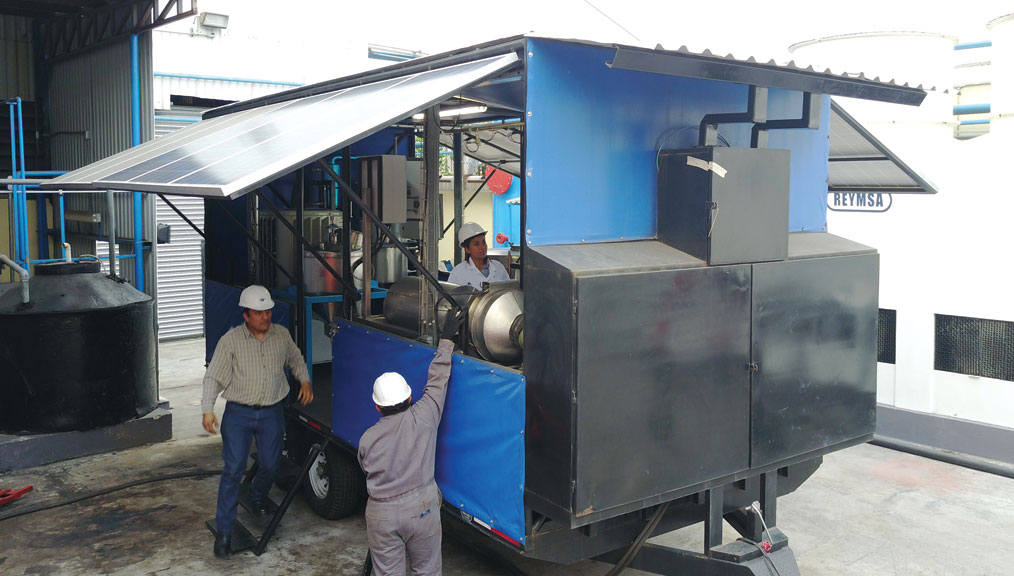By the time green coffee arrives in the hands of a roaster, it’s been stripped of every indication it was once the core of a plump fruit. Milling equipment removes the pulp, mucilage, and parchment from the bean, often leaving these byproducts as waste. Waste production is a concern because untreated pulp emits methane gas, and byproducts have the potential to harm soil and pollute local water sources.
In November, Anna Brones examined some of the ways coffee byproducts are being repurposed, including coffee flour, cascara tea, biofuels, and T-shirt ink. We continue the discussion by examining a few related projects happening in coffee-producing countries.
[T]he ideal agronomy would be one that all of the products and subproducts of the plant have some value to the producer,” says Demetrio Arandia Muguira, president of Descamex, a Mexican decaf processor based in Córdoba, Veracruz.
Two years ago, Muguira and his team launched a project to develop a mobile coffee recycling unit. They partnered with Universidad Autónoma de Querétaro (UAQ) and Centro de Investigación y Desarrollo Tecnológico en Electroquímica (CIDETEQ) to conduct research into the best alternatives for extracting caffeine and chlorogenic acids from the pulp of coffee cherries.
Though the caffeine yield from the pulp is relatively low compared to coffee beans, both the caffeine and chlorogenic acids can be extracted and sold. “The main consideration taken for the development was to try to get the best extraction possible,” Muguira says. “The purpose of this extraction plant is to allow the coffee producer to have an additional income from the subproducts of their farms.”
To accomplish this, the teams set out to build a unit that was relatively small, utilized a cost-effective process to extract the subproducts, and was transportable between regions, allowing the unit to be relocated according to harvest schedules.
Once cherries have passed through the wet milling process, semi-wet pulp is manually loaded into the mobile system, which operates in three phases. First, the caffeine and chlorogenic acids are extracted from the pulp. Then, a decantation and distillation process is used to separate the caffeine and chlorogenic acids from the extract in liquid form. The caffeine and chlorogenic acids are recovered from the liquid, and the remaining pulp is dried.
Descamex used the unit on its farms for the first time this season and hopes to roll out a full operation next year. The pilot project is housed inside a trailer that can be pulled from one mill to another by truck.
Muguira’s company opted for a scientific approach to transforming byproducts into valuable resources, but it doesn’t take a team of engineers to reduce waste.
Distant Lands Coffee owns a collection of farms and mills across Costa Rica (and one mill in Colombia), where it’s common practice for farmers to sell their coffee to mills in whole bean form. “We as a mill receive lots and lots and lots of coffee cherry,” says Scott Merle, vice president of sales for Distant Lands’ green coffee division.
The organization has several systems in place to combat coffee cherry waste and assist area farmers. The largest use of pulp? As compost, both on their own farms and for growers who bring cherries to the mills.
“Because coffee producers sell their whole cherries, they don’t have access to that byproduct,” Merle says.
Distant Lands adds a bit of lime to the pulp and mixes it into a compost, then sells it back to farmers at cost for use on their farms. Any remaining compost is used across the six farms owned by the company.
Using pulp as compost is a relatively common way to repurpose milling byproducts. Distant Lands has also found uses for miel, the mucilage layer of the bean. “That should be considered a byproduct of the coffee because that’s either pollution or waste, or it needs to get reused somewhere,” Merle says, referring to the mucilage that’s trapped by mechanical equipment. “We recapture all that mucilage, all that miel, and we’ve been adding that back into the compost too.”
Distant Lands also uses parchment removed by dry milling equipment to fuel the dryers—a process they’ve relied on for over fifteen years. “We’ve got specially designed biomass furnaces that we use to generate the heat needed to dry the washed coffee,” Merle says. A machine packs the coffee parchment into discs, then feeds them into the furnace as a fuel alternative to wood.
The projects spearheaded by Distant Lands and Descamex are just two examples of producers working to find better solutions for coffee byproducts at origin—there are many others, and even more developments on the horizon. Just as Muguira described the ideal agronomy, it’s the nature of farmers to be resourceful when it comes to finding new uses for byproducts; no one wins when there’s waste.
—Ellie Bradley is Fresh Cup’s editor.
















